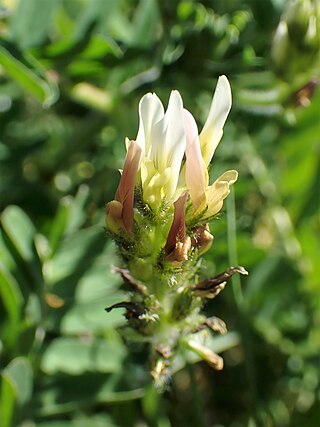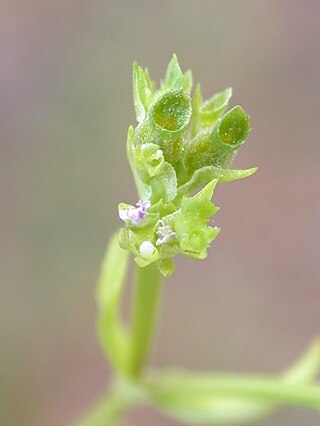
Minuartia is a genus of flowering plants commonly known as sandworts in the family Caryophyllaceae.

Tripodion tetraphyllum is a species of flowering plant in the legume family, Fabaceae. It is an annual herb, commonly known as annual kidney vetch, native to the Mediterranean Basin of southern Europe, North Africa, and western Asia. It grows in the Mediterranean–Sahara transition zone of North Africa, and in anthropic landscapes. It is the sole species in genus Tripodion, which belongs to subfamily Faboideae.
Sabulina californica, commonly known as California sandwort, is a species of flowering plant in the family Caryophyllaceae.
Sabulina decumbens is a rare species of flowering plant in the family Caryophyllaceae known by the common names The Lassics sandwort and Lassicus stitchwort.

Sabulina douglasii is a species of flowering plant in the family Caryophyllaceae known by the common name Douglas' stitchwort.
Sabulina pusilla is a species of flowering plant in the family Caryophyllaceae known by the common names annual sandwort and dwarf stitchwort.

Sabulina rubella is a species of flowering plant in the family Caryophyllaceae known by several common names, including beautiful sandwort, mountain sandwort, Arctic sandwort, and boreal stitchwort. It has a circumboreal distribution, occurring throughout the northernmost Northern Hemisphere from the Arctic Circle on the Arctic tundra into the alpine climates of mountainous areas in temperate Eurasia and North America. It grows in rocky, moist, often barren habitat, including gravelly, sparsely vegetated slopes with little organic matter. It is a calciphile, growing in calcareous substrates such as soils rich in decomposed limestone.

Sabulina stricta is a species of flowering plant in the family Caryophyllaceae known by the common names bog stitchwort, Teesdale sandwort and rock sandwort. It has a circumboreal distribution, occurring throughout much of the northernmost Northern Hemisphere from the lower Arctic into the alpine climates of mountainous areas in temperate Eurasia and North America. It grows in several types of habitat, including meadows, marshes, heath, beaches and bars, and arctic and alpine tundra.

Sabulina verna is a scarce species of flowering plant in the family Caryophyllaceae, known by the common names spring sandwort, leadwort, golden moss, or Irish moss. It is a small mat-forming, perennial herb. It was first described as Arenaria verna by Carl Linnaeus in 1767 and is known by several synonyms including Minuartia verna.

Astragalus boeticus, the yellow milk vetch, or Swedish coffee is a species of annual herb in the family Fabaceae. It is native to the Mediterranean and the Middle East.

Callitriche truncata, the short leaved water starwort, is a species of plant in the family Plantaginaceae. It is an aquatic subshrub native to the Mediterranean Basin countries of southern Europe from Spain to Greece and of North Africa from Morocco to Libya, as well as Turkey, Lebanon, and Syria in the eastern Mediterranean, Belgium, the Netherlands, Great Britain, and Ireland in western Europe, eastern European Russia, and the western Himalayas.

Valeriana calcitrapae is a species of annual herb in the family Caprifoliaceae. Individuals can grow to 18 cm tall. It is native to the Mediterranean Basin, Crimea, and Macaronesia.

Euphorbia terracina, commonly known as the Geraldton carnation weed and False caper, is a species of perennial herb in the family Euphorbiaceae. It has a self-supporting growth form and simple, broad leaves. Flowers are visited by Lipotriches brachysoma, Lipotriches natalensis, Lipotriches crassula, and Nomia bouyssoui. It produces small, three lobed fruits, with each lobe containing one seed.

Kickxia commutata, the Mediterranean fluellen, is a species of perennial herb in the family Plantaginaceae. They have a self-supporting growth form and simple, broad leaves. Individuals can grow to 5 cm tall.

Linaria chalepensis is a white-flowered plant found in southern Europe, belonging to the family Plantaginaceae.

Valeriana eriocarpa is a species of flowering plant in the family Caprifoliaceae. It is an annual native to western and southern Europe, northwestern Turkey, and north Africa.

Valeriana muricata, synonym Valerianella muricata, is a species of flowering plant in the family Caprifoliaceae. It is an annual which ranges from Greece and the Eastern Mediterranean through western and central Asia, the Caucasus, and the western Himalayas.

Reichardia intermedia is a species of plant in the family Asteraceae.

Sedum litoreum is a species of succulent annual herb in the family Crassulaceae. Individuals can grow to 3.7 cm. It is native to the central and eastern Mediterranean, from Corsica and Sardinia to Italy, Sicily, former Yugoslavia, Albania, Greece and the Greek Islands, Turkey, Cyprus, and the Levant.

Sabulina is a genus of flowering plants in the family Caryophyllaceae. It includes 74 species native to temperate and subtropical North America, Eurasia, and North Africa.
















